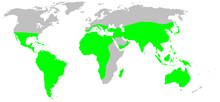Crevice weaver
| Crevice weaver spiders | |
|---|---|
 |
|
| Filistatid web | |
| Scientific classification | |
| Kingdom: | Animalia |
| Phylum: | Arthropoda |
| Subphylum: | Chelicerata |
| Class: | Arachnida |
| Order: | Araneae |
| Infraorder: | Araneomorphae |
| Family: |
Filistatidae Ausserer, 1867 |
| Genera | |
|
See text. |
|
| Diversity | |
| 18 genera, > 120 species | |
 |
|
| Distribution is approximate | |
See text.
The crevice weaver spiders (family Filistatidae) comprise cribellate spiders with features that have been regarded as "primitive" for araneomorph spiders. They are weavers of funnel or tube webs. The family contains 18 genera and more than 120 described species worldwide.
One of the most abundant members of this family in the Americas is the southern house spider (Kukulcania hibernalis). Named after the fierce Meso-American god Kukulkan, the females are large (up to nearly 20 mm) dark-colored spiders and males are light brown, smaller (about 10 mm), but more long-legged and with palps that are held together in front of their carapaces like the horn of a unicorn. The males also have a darker streak on the center of the dorsal carapace that causes them to be often mistaken for brown recluse spiders. The tiny members of the genus Filistatinella are like miniature versions of Kukulcania. The nominate genus Filistata is Afro-Eurasian in distribution. In many older books the species from the Americas now placed in the genus Kukulcania are placed in Filistata.
A striking visual characteristic of the family, beside dimorphism, is the unusual upward bend encountered near the femur of the first pair of legs. While resembling hydraulic muscle mechanisms akin to arthropods, this modification actually allows the spider to retain the prey directly from the crevice it occupies. Also, if the larger prey ever tries to pull it from the crevice, the spider can use these legs to "grab" to the side walls and hence make it difficult. Many Kukulcania species also use them to dig holes in the soft ground at a 25- to 30-degree angle.
The family Filistatidae was created in 1867 by Anton Ausserer. It was based on the species he called Filistata bicolor (now Filistata insidiatrix), a Mediterranean species also found in southern Austria.
...
Wikipedia
